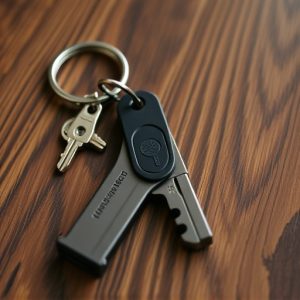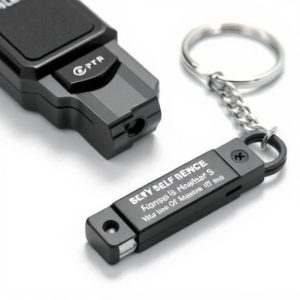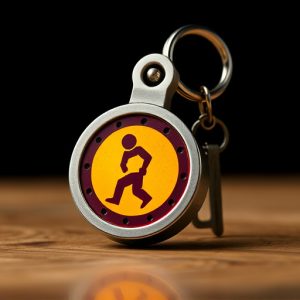Personal Safety Keychains: Features, Legalities, and Prohibited Weapons
In an era focused on personal safety, traditional keychains' lack of emergency features is addr…….
In an era focused on personal safety, traditional keychains' lack of emergency features is addressed by advanced, multi-functional keychains offering flashlights, alarms, and tracking. These innovative tools balance convenience with security, empowering users to handle unexpected situations effectively while navigating legal restrictions like the Prohibited Keychain Weapons List. A well-designed keychain should include accessible emergency contacts, reliable alarms, self-defense features, GPS tracking, and first aid supplies, used responsibly under local laws and best practices to ensure effectiveness and legality.
In today’s world, personal safety is paramount. One innovative solution gaining traction is the safety keychain—a compact emergency tool that can be a lifesaver in unpredictable situations. This article explores the significance of these keychains, delving into their versatile features and how they transform everyday accessories into powerful safety devices. From understanding the need for such tools to navigating legal considerations, we’ll uncover the essentials, including a prohibited keychain weapons list, to help you design and utilize your own personal safety keychain effectively.
- Understanding the Need for Safe Keychains
- What Makes a Keychain an Emergency Tool?
- Common Prohibited Keychain Weapons and Features
- Designing and Using Your Personal Safety Keychain
- Legal Considerations and Best Practices
Understanding the Need for Safe Keychains
In today’s world, where personal safety is a top concern, understanding the need for safe keychains becomes paramount. Traditional keychains often lack essential emergency features, making them less than ideal in high-risk situations. Many everyday objects that were once considered harmless—from flashlights to multi-tools—have been banned due to their potential misuse as prohibited keychain weapons. This reality underscores the growing demand for innovative solutions like safety keychains equipped with built-in emergency tools and features.
These advanced keychains cater to individuals seeking peace of mind, offering a range of functions beyond simple key retention. They may include components such as flashlights, emergency alarm systems, or even personal tracking devices. By integrating these features, safety keychains empower users to handle unexpected scenarios more effectively. Additionally, they serve as a reminder that convenience and security can coexist, challenging the notion that practical tools must necessarily be prohibited items on the keychain weapons list.
What Makes a Keychain an Emergency Tool?
A keychain isn’t just a convenient way to carry your keys; it can also serve as an essential emergency tool, equipped with features designed to help in unexpected situations. What transforms a simple keychain into a potential life-saver is its compactness and accessibility—it’s always within reach and rarely draws attention. Features such as a built-in alarm, flash light, or even a window breaker can be the difference between safety and danger during emergencies.
While many keychains claim to offer emergency functionality, not all of them are created equal. The true value lies in understanding what makes a keychain an effective tool for emergencies. Avoid so-called “prohibited keychain weapons” that may include sharp blades or objects designed for self-defense—these can be illegal and impractical in urgent situations where clear thinking and immediate safety are paramount. Look instead for versatile tools that offer multiple functions, combining alarm, light, and breaking capabilities into a single, discreet device.
Common Prohibited Keychain Weapons and Features
In many public spaces, certain keychain features and weapons are strictly prohibited due to safety regulations and laws. Understanding this prohibited list is crucial when considering an emergency keychain. Common items like knives, scissors, and even some multi-tool keychains fall under these restrictions. These objects, while useful in outdoor or survival scenarios, pose a risk in crowded areas and can be easily concealed on a keychain, making them potentially dangerous.
The Prohibited Keychain Weapons List typically includes any sharp objects with cutting capabilities, as well as tools that can be used as weapons. This list varies by region and venue, but it generally encompasses items like box cutters, flashlights with removable or interchangeable batteries (due to the potential for a hazardous projectile), and even certain types of self-defense sprays. Always check local regulations to ensure your chosen emergency keychain complies with these restrictions, ensuring safety for yourself and those around you.
Designing and Using Your Personal Safety Keychain
Designing your personal safety keychain involves careful consideration of essential features tailored to your needs. Firstly, ensure it includes emergency contact information readily accessible through a quick-release mechanism. Secondly, incorporate a reliable alarm or LED flasher for deterring potential assailants and alerting others to your distress. Some key features to look out for include a sharp metal edge for self-defense, a built-in GPS tracker for location sharing, and even a small first aid kit.
Using the keychain effectively necessitates familiarity with its functions. Practice activating the alarm and flasher regularly to ensure their reliability in high-stress situations. Keep emergency contact details up-to-date. Be mindful of local laws regarding prohibited keychain weapons; understand what constitutes legal self-defense to avoid any legal complications. Regular maintenance, such as checking battery life and keeping your contacts current, is vital for ensuring the keychain remains a valuable safety tool.
Legal Considerations and Best Practices
When designing a safety keychain with emergency features, it’s crucial to understand legal considerations and best practices in order to ensure product compliance and user safety. Each country and region has its own regulations regarding what constitutes a permissible personal protection tool. For instance, many places have a prohibited keychain weapons list that includes items like knives or sharp objects designed for self-defense. It’s essential to thoroughly research local laws and obtain any necessary permits or certifications before production and distribution.
Best practices dictating the functionality, design, and marketing of such keychains should prioritize user safety without infringing on legal boundaries. This includes features like a secure locking mechanism, easy accessibility, and clear labeling to communicate their intended purpose. Additionally, responsible marketing strategies should avoid framing these keychains as stealth weapons, focusing instead on their life-saving capabilities during emergencies. Compliance with these guidelines ensures that the product remains legal, effective, and promotes public safety.
In today’s world, personal safety is paramount. By integrating an emergency-ready keychain into your routine, you can transform a small accessory into a powerful tool. Understanding what makes a keychain an emergency device and navigating legal considerations equips individuals to make informed choices. Remember that while exploring designs and features, knowing the prohibited keychain weapons list is crucial for both safety and legality. With the right knowledge, creating or acquiring your own safety keychain can be a game-changer, offering peace of mind in an unpredictable landscape.


